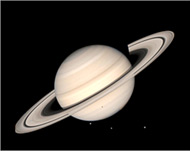Saturn’s rings baffle scientists
New observations by the international Cassini spacecraft reveal that Saturn’s trademark shimmering rings, which have dazzled astronomers since Galileo’s time, have dramatically changed over the past 25 years.

Among the most surprising findings is that parts of Saturn’s innermost ring – the D ring – have grown dimmer since the Voyager spacecraft flew by the planet in 1981. A piece of the D ring also has shifted, moving 200km inward towards Saturn.
While scientists puzzle over what caused Saturn’s D ring to change in such a short period, the observations could tell something about the age and lifetime of ringed planets.
Important clues
Scientists also are interested in Saturn and its magnificent rings because they are a model of the disk of gas and dust that initially surrounded the sun. Studying them could yield important clues about how the planets apparently formed 4 1/2 billion years ago.
The D ring finding was among several Cassini-related discoveries announced on Monday at a meeting of the American Astronomical Society’s division of planetary sciences in Cambridge, England.
 |
|
The rings could give clues about |
Scientists also unexpectedly found that ice particles that make up Saturn’s main rings – the A, B, and C rings – were spinning slower than expected.
Scientists expected the denser A and B rings – where crowds of particles crash into one another like bumper cars – to rotate faster than the sparser C ring. The spin rates were determined by measuring the temperature of the particles.
“I don’t think Saturn’s rings will disappear anytime soon, but this tells us how the rings are evolving and how long they might last,” deputy project scientist Linda Spilker said in a telephone interview from England.
Ice particles
Ultraviolet imaging by the Cassini spacecraft also found that Saturn’s outermost main ring – the A ring – appears to contain more empty space than originally thought.
Scientists say ice particles in the ring are trapped in huge clumps of debris that are routinely broken apart and put back together by gravity.
Joshua Colwell, a science team member from the University of Colorado, Boulder, noted that the space between the clumps was greater than the size of the clumps themselves, suggesting that there were few particles between clumps.
The ring observations were made this summer when the Cassini spacecraft had a prime viewing angle of the planet from orbit.
The $3.3-billion Cassini mission, funded by Nasa and the European and Italian space agencies, was launched in 1997 and took seven years to reach Saturn to explore the ringed planet and its many moons.
Cassini is managed by Nasa’s Jet Propulsion Laboratory in
Pasadena, California.